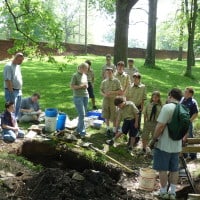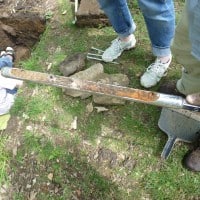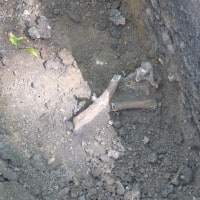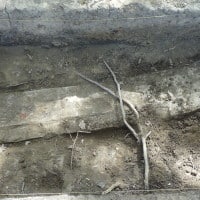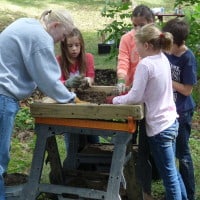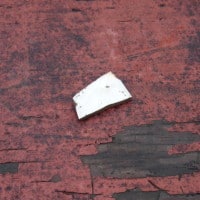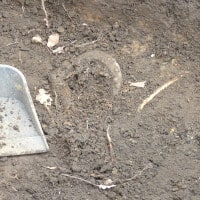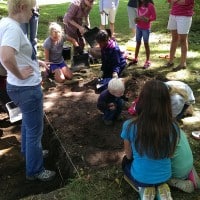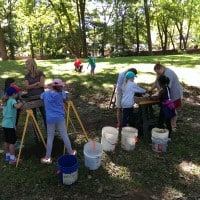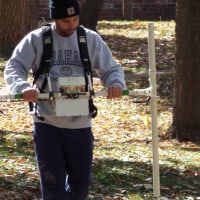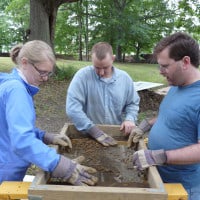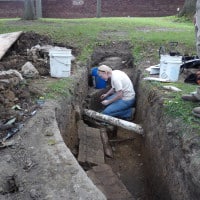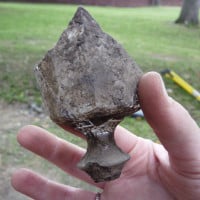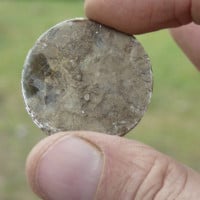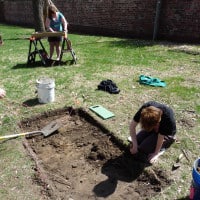Reflecting Pool
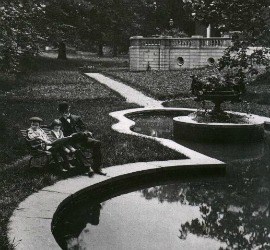
Lew built a reflecting pool northwest of the Study in 1898. The pool was surrounded by brick walls and topped with flat stone coping. It did not have a brick, stone, or concrete base. The pool contained a round brick island with a large, decorative iron urn resting on a limestone pedestal. Wallace filled it with dirt after he filled in the moat adjacent to the Study. For over 110 years, it remained buried and largely forgotten.
Reflecting Pool Restoration
In 2017, brothers Chuck and Mike Beemer indicated they wanted to bring this important feature back to life. They sponsored a restoration as a memorial to their parents, Gordon and Julia Beemer. Julia was a great granddaughter of notable educator Caleb Mills.
The restoration of the pool included significant excavation of the fill with a careful archaeological study done in concert with the removal of the dirt. The perimeter brick wall for the pool was beautifully rebuilt by Mike Dowell of Dowell Masonry. Mike installed capstones replicating Wallace’s original trim.
The large urn that stood on the island in the pool was shipped off for restoration. Workers regraded the site to replicate its appearance during Wallace’s lifetime.
Planting the Pool
In a concession to safety and maintenance, the pool was planted in a uniform ground cover (liriope) to create a sunken garden, rather than refilling the pool with water. The planting in General Wallace’s gold urn was an experiment in texture and color. In historic photos, large plants are surrounded by flowers cascaded over the rim of the urn. In 2018, the palm, elephant ears, and large leaf coleus grew extremely well. The plants grown for color (lobelia, begonias, caladiums) faded into the shade of the pool.
This promises to be one of the most important restorations ever undertaken on the property. The restoration promises to open up new avenues for educating the public on archaeology, Lew Wallace’s horticultural interests, and changing landscape trends of the early 20th century.
History Beneath Us
History Beneath Us began in 2010 when the Museum teamed up with Crawfordsville native Anne Shaw, Dr. Chris Moore, and archaeology students from the University of Indianapolis to excavate portions of the grounds. They have found the western edge of the reflecting pool and discovered that the pool was lined with bricks but does not have a brick or stone base. The approximate depth of the pool is four feet, indicating that Wallace could have used this pool to winter over fish from his moat.
Several artifacts have been found in the dirt used when the pool was filled in. None of these can be definitively tied to Lew Wallace, because we are not sure where the fill dirt came from. There is also a builder’s trench on the outside of the pool wall that contains artifacts that should date to the construction of the pool. As a result, these items are probably connected to Lew or the contractor who built the pool. The archaeologists have uncovered ceramics (pieces of plates, bowls and teacups), glass bottles, metal utensils and containers, nails and brick in these areas.
There is also a promising area near the Carriage House and the southern brick wall where evidence of a possible foundation was found. This area could have been a cistern, privy or an outbuilding.
